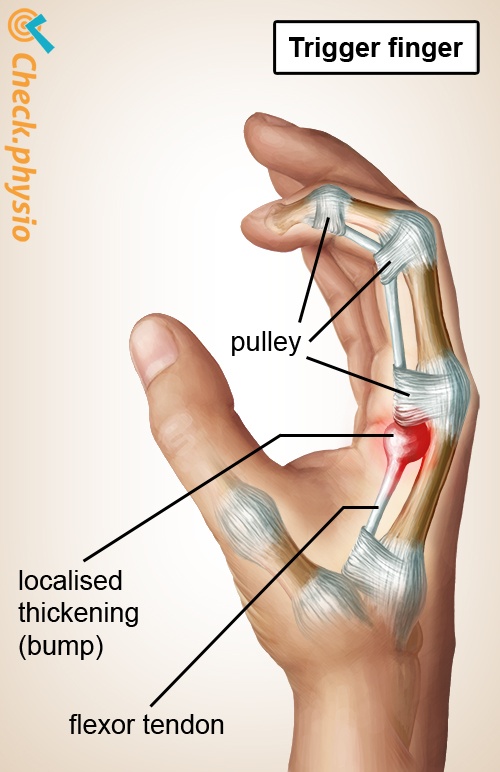- Conditions
- Trigger finger
Trigger finger Stenosing tenosynovitis / trigger thumb
Introduction
Trigger finger is a condition where it is difficult to extend the finger and the finger then unlocks with a snap. It is caused by localised thickening of the tendon that glides through a narrow tunnel in the hand.
If the thumb is affected, we call this trigger thumb.

Description of the condition
The tendons that flex the fingers are located on the front of the hand. They run through small tunnels called 'pulleys'. The pulleys ensure that the tendon remains in position and that forces are passed on as if by a pulley block.
If localised thickening (a bump) forms in the flexor tendon, then this bump might not fit through the tunnel. This causes the finger to 'lock', particularly when extending the finger. In such situations, the flexor tendon is pulled towards the finger tips like a rope, meaning that the bump has to pass through the tunnel. There is some initial resistance and then it passes through the tunnel in one go.
The problem is almost always in the tunnel that is located just below the base of the finger. However, the patient feels as if the symptoms are caused higher up, because the tendon moves the finger joints located higher up.
Cause and origin
Trigger finger is more common in women. It is more common in the age category 40 to 70 years and in children under the age of 6 years.
The symptom usually start with an annoying or painful sensations just below the base of the finger. Next, the normal and smooth movement of the flexor tendon is inhibited when the person flexes or extends the finger. The thickened tendon that is pulled through the pulley causes pain and results in the typical trigger finger effect.
The area also becomes more inflamed, because the tendon becomes impinged in the pulley. This in turn causes extra swelling, causing the tendon to move through the pulley with even greater difficulty. This creates a vicious circle.
Signs & symptoms
- Pain along the front of the hand, just below the base of the finger.
- The finger locks when trying to extend and then snaps into place in one go.
- In some cases, the finger remains in the flexed position and can no longer be extended.
- The base of the finger can feel swollen.
Diagnosis
The diagnosis is usually straightforward because this condition presents very characteristic symptoms. After taking a history and conducting a physical examination of the hand, it is usually clear whether it is a trigger finger. The healthcare professional feels the place where the tendon is stuck and asks the patient to actively bend and straighten the finger. No additional investigation is necessary.
Treatment and recovery
If the symptoms have developed very recently, a wait-and-see approach will first be implemented. If no improvement occurs, one could consider administering a corticosteroid injection (anti-inflammatories). This results in improvement in most cases. If this also does not provide relief, the pulley can be cleaved surgically so that the tendon can move smoothly again.
More info
You can check your symptoms using the online physiotherapy check or make an appointment with a physiotherapy practice in your area.
References
Peters-Veluthamaningal, C., Willems, W., Smeets, J.G.E., Windt, D.A.W.M. Van der, Spies, M.N., Strackee, S.D., Vos, K., Wind, L.A. & Geraets, J.J.X.R. (2010) NHG-Standaard. Hand- en polsklachten Huisarts Wet. 2010:53(1):22-39.
Verhaar, J.A.N. & Linden, A.J. van der (2005) Orthopedie Houten: Bohn Stafleu van Loghum.
